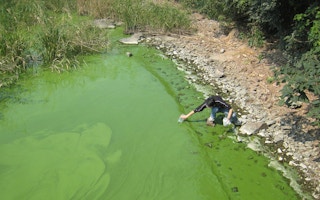US scientists have identified a new hazard linked to global warming: a change in ocean water chemistry causing nitrite pollution that could trigger toxic algal blooms and even dead zones in coastal waters.
Nitrite is a byproduct of fertiliser decay, and is becoming increasingly common as a potential pollutant as ocean temperatures rise. Humans use sodium nitrite to preserve meat products such as bacon and sausage, but health authorities would prefer to see less of it in the human diet.
In the wider world nitrite becomes available as microbial organisms consume ammonium in fertiliser waste that washes down rivers and estuaries to the coasts, and although it is a natural product of natural biochemical processes, too much nitrite is not healthy for the environment either.
It can affect the species and numbers of single-celled plants that live at sea, and trigger toxic blooms that consume the ocean’s oxygen and create zones where no fish can survive.
“Rising ocean temperatures are changing the way coastal ecosystems – and probably terrestrial ecosystems, too – process nitrogen,” said James Hollibaugh, professor of marine sciences at the University of Georgia at Athens. “Much of the global nitrogen cycle takes place in the coastal zone.”
The ocean environment is changing: the seas are becoming measurably more acidic as they absorb ever more atmospheric carbon dioxide, the product of fossil fuel consumption that is driving global warming.
Repeated warnings
Researchers have more than once warned of “dead zones” and toxic algal blooms as a consequence of changing climatic conditions. Ocean temperatures are increasing, and this in turn encourages a new set of biochemical processes.
Professor Hollibaugh and a colleague report in the journal Environmental Science and Technology that over the course of eight summers they measured peaks of nitrite, alongside massive increases in the numbers of the microorganisms that produce it, in coastal waters off Georgia.
One argument has it that nitrite accumulation is a consequence of oxygen deficiency. The Georgia scientists wondered if there could be another explanation.
In the laboratory, they exposed single-celled creatures called Thaumarchaea to different temperature levels, and found that as the thermometer went up, so did the nitrite output.
The microbes involved in the process co-operated to convert ammonium to nitrate, with a nitrite stage in the process: a reaction that chemists would write as NH3 to NO2 to NO3. Higher temperatures interfered with the second stage of the reaction, leaving a nitrite surplus.
That was what happened in the lab. To test the result, the scientists then analysed environmental monitoring data from 270 locations around 29 temperate and subtropical lagoons and estuaries across the US, France and Bermuda, to confirm the finding: the link between higher temperatures and nitrite accumulation held.
“
The information gained from monitoring programmes can be used not only to forecast what is going to happen down the road, but also to come up with potential solutions.
“The same process, though we didn’t look at it specifically, takes place in regards to fertilising soil for agricultural purposes. It affects farmers and their efficient use of fertiliser – when they should apply it and what form it should be in – and ultimately much of that fertiliser will end up in the waterways, which can lead to algal blooms that choke out other species,” said Professor Hollibaugh.
And this in turn raises the spectre of positive feedback: more nitrite could then lead to more nitrous oxide in the atmosphere. This is one of the greenhouse gases that would then accelerate atmospheric warming, leading to even more nitrite in the estuaries and lagoons, and then more nitrous oxide again.
“If you live on a marsh and look out over the water, you’re probably not going to notice it, but if you like shellfish, like to fish, like recreational water sports, then these findings do matter,” Professor Hollibaugh said.
“The information gained from monitoring programmes, like the ones we used to analyse temperature and nitrite data across the country and in other countries, can be used not only to forecast what is going to happen down the road and the longer-term consequences of management decisions, but also to come up with potential solutions for the problem.
“The data collected by these programmes are important for wise management of our resources.”
This story was published with permission from Climate News Network.










